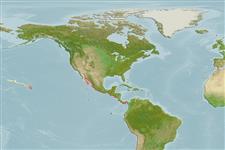>
Eupercaria/misc (Various families in series Eupercaria) >
Haemulidae (Grunts) > Haemulinae
Etymology: Haemulon: Greek, haimaleos = bloody (Ref. 45335).
More on author: Gill.
Environment: milieu / climate zone / Tiefenbereich / distribution range
Ökologie
seewasser riff-verbunden; tiefenbereich 3 - 30 m (Ref. 5227), usually 10 - 12 m (Ref. 5227). Tropical; 28°N - 7°N
Eastern Central Pacific: Gulf of California to Panama.
Size / Gewicht / Alter
Geschlechtsreife: Lm ? range ? - ? cm
Max length : 71.0 cm TL Männchen/unbestimmt; (Ref. 55763); common length : 30.0 cm TL Männchen/unbestimmt; (Ref. 55763); max. veröff. Gewicht: 2.3 kg (Ref. 40926)
Body oblong, compressed and not very deep (depth contained 2.9 to 3.3 times in standard length ); mouth large and terminal, its posterior end located under the anterior rim of the eye; first gill arch with 18 to 22 gill rakers; dorsal fin notched, with 11 to 12 spines and 16 to 18 soft rays (XI-XII, 16-18); second anal spine slightly longer and stronger than third; scale series above lateral line oblique; juveniles with 3 vertical bars and a caudal spot that disappears with age; adults with 6 or 7 dark gray vertical bars on a yellowish body; head with a dark spot behind the eye (Ref. 55763).
Body shape (shape guide): fusiform / normal.
Forms schools in coastal reefs during the day but disperses at night in search for food. Often feed by digging in sand (Ref. 5227).
Life cycle and mating behavior
Geschlechtsreife | Fortpflanzung | Ablaichen | Eier | Fecundity | Larven
Oviparous, distinct pairing during breeding (Ref. 205).
McKay, R.J. and M. Schneider, 1995. Haemulidae. Burros, corocoros, chulas, gallinazos, roncos. p. 1136-1173. In W. Fischer, F. Krupp, W. Schneider, C. Sommer, K.E. Carpenter and V. Niem (eds.) Guia FAO para Identification de Especies para lo Fines de la Pesca. Pacifico Centro-Oriental. 3 Vols. FAO, Rome. (Ref. 9114)
IUCN Rote Liste Status (Ref. 130435: Version 2025-1)
Bedrohung für Menschen
Harmless
Nutzung durch Menschen
Fischereien: weniger kommerziell
Tools
Zusatzinformationen
Download XML
Internet Quellen
Estimates based on models
Preferred temperature (Ref.
123201): 22.9 - 29.1, mean 28 °C (based on 149 cells).
Phylogenetic diversity index (Ref.
82804): PD
50 = 0.5000 [Uniqueness, from 0.5 = low to 2.0 = high].
Bayesian length-weight: a=0.02512 (0.01502 - 0.04202), b=3.02 (2.88 - 3.16), in cm total length, based on LWR estimates for this species & Genus-body shape (Ref.
93245).
Trophic level (Ref.
69278): 4.2 ±0.73 se; based on food items.
Generation time: 8.3 ( na - na) years. Estimated as median ln(3)/K based on 1
growth studies.
Widerstandsfähigkeit (Ref.
120179): niedrig, Verdopplung der Population dauert 4,5 - 14 Jahre. (K=0.13).
Fishing Vulnerability (Ref.
59153): High vulnerability (58 of 100).
🛈
Nutrients (Ref.
124155): Calcium = 26.6 [9.7, 51.1] mg/100g; Iron = 0.52 [0.26, 0.95] mg/100g; Protein = 19.4 [17.5, 21.2] %; Omega3 = 0.118 [0.064, 0.199] g/100g; Selenium = 30.9 [16.3, 56.9] μg/100g; VitaminA = 121 [44, 318] μg/100g; Zinc = 0.879 [0.599, 1.285] mg/100g (wet weight);
